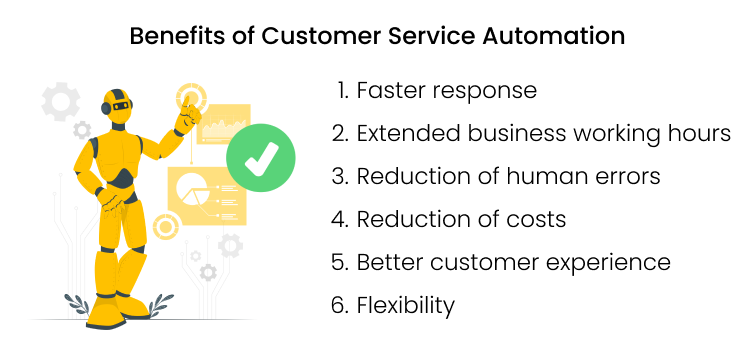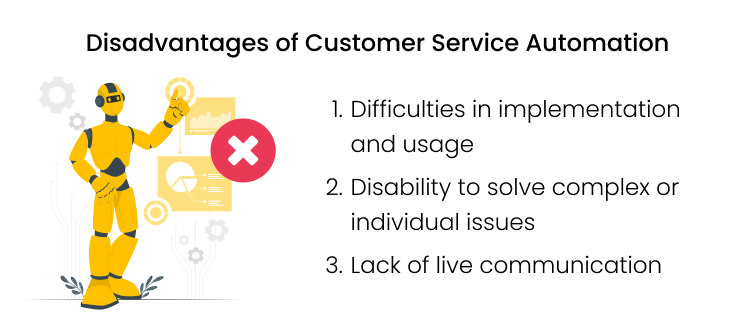Automated customer service is a double-edged sword. It is the ability for customers to receive an answer quickly and without the need for human assistance. For customer service executives, it is a necessary evil that can help them keep up with the growing volume of contacts. For agents, customer service automation can even be treated as a threat to their jobs.
But no matter how automated customer service is treated, it is still a necessary transformation that a business needs to make in order to stay competitive in today’s world. If done successfully, it can improve the experience for all — customers, business executives, and agents.
In our article, we will dwell on what an automated customer support system is. And what automated technologies can speed up and improve the working processes, as well as what tools and integrations can make your Zendesk work on autopilot? So, keep on reading.
What Is Automated Customer Service?
Automated customer service refers to using technology—such as AI, machine learning, and natural language processing—to handle customer inquiries and support tasks instead of relying solely on human agents. Automation can be partial, assisting agents with repetitive tasks, or fully automated, providing self-service solutions without human intervention.

We want to emphasize that automation solutions don’t put humans out of work. Instead, it is the next step in workforce evolution as it frees the customer support team from manual and repetitive tasks. Also, it lets them focus on more important and complex ones.
The Driving Forces of Customer Support Automation
What are the driving forces of automation? They are customers’ preferences and expectations.
In today’s digital age, customers do not want to wait, and they expect instant help with their issues 24/7. They also expect nothing less than a personalized and specific approach, mostly through messaging. And that’s the main reason for digital transformations and automation for many call centers and the wide use of live chats, mobile messaging, and other tools.
How does Customer Service Automation Work?
Customer service automation takes over repetitive tasks and helps customers get what they need faster. It’s like giving your support system a set of superpowers. Here’s how it works:
- Chatbots and AI Tools: You’ve probably interacted with a chatbot before. These tools are powered by AI and can answer questions instantly. They’re great for simple queries like “What’s my order status?” or “How do I reset my password?” They can even guide customers through processes without needing a human to step in.
- Automated Ticket Routing: Instead of manually sorting through requests, automation tools can automatically send tickets to the right person or team. If it’s a billing issue, it goes to the finance team. Tech problem? Straight to the IT crew. This saves time and reduces confusion.
- Self-Service Portals: Automated knowledge bases are like having a library of answers ready for customers. They type in their issue, and the system shows them helpful articles or videos. It’s fast and easy, and customers love finding solutions on their own.
- Proactive Updates: Automation keeps customers in the loop by sending updates like “Your order has shipped!” or “We’ve received your request and will get back to you soon.” These little touches go a long way in building trust.
- Seamless Integrations: Automation tools work hand-in-hand with platforms like Zendesk, HubSpot, Freshdesk, etc. They pull up customer history, preferences, and past interactions so agents can respond faster and make conversations feel more personal.
In short, automation in customer service doesn’t just help businesses—it makes things smoother and more convenient for everyone involved.
Automated Customer Service Examples
There are numerous automation tools that you can use to automate your customer service. Among the most popular ones are:
- Chatbots are used for customer self-service;
- CRM automation can ease the work of your agents (for example, automatic case creation, auto-suggested knowledge content, etc.);
- Automated incoming email processing and responding;
- Conversational Interactive Voice Response (IVR);
- Customer knowledge bases;
- Frequently Asked Questions (FAQ);
- Social listening software;
- Integrations that help automate the work of your help center.
Automated Customer Service: Pros and Cons
Customer service automation is undeniably powerful, but it’s not a one-size-fits-all solution. Like every innovation, it comes with its strengths and challenges. Understanding these can help you decide how to strike the right balance between automation and the human touch.
Benefits of Customer Service Automation
Now, let’s look closer at the advantages of automated customer service in almost any business model.

1. Faster response
Speed is a crucial factor in providing exceptional customer service. Did you know that an average customer response benchmark for such world giants as Facebook and X is only 15 minutes? What’s more, customers expect an instant (and by instant, we mean less than a minute) reply on live chat, call, or SMS.
Automation of your call center can help you even exceed these expectations. How? It’s simple. Equipped with an email automation tool that can read your incoming emails and generate responses for agents’ review, you can save up to one-fifth of the time needed to process.
2. Extended business working hours
As we have already mentioned, customers want immediate resolution of their issues. And the only way to provide such a service without enlarging your workforce is through automation. For example, some customer services use chatbots as the first step in communication with customers. If the problem remains unresolved, they escalate an issue to the live agent only.
3. Reduction of human errors
As you know, to err is human. But this statement doesn't work in customer service. Of course, people are great when it comes to showing empathy to others. But they can’t compete on accuracy and high speed when it comes to some repetitive and manual tasks like data entering or finding the one relevant article in the knowledge base from thousands available. That is when automation tools and software come into play.
Besides, some automation tools can become even smarter and more accurate over time as they learn from previous interactions and are able to adjust their behavior.
4. Reduction of costs
Automation of your call center can decrease the costs per interaction with a customer. For example, using chatbots that can resolve issues without the help of the agents is a very cost-effective way because they exclude many other steps like a phone call, agent work, etc.
According to a study by McKinsey, companies that have implemented automation can save up to 40% on service costs. What’s more, email automation software can answer emails for $1 each, compared to the $5-6 you spend on each email when an agent processes it.
5. Better customer experience
According to Dimensional Research, 72% of respondents reported that the main reason for their negative customer experience was the need to explain their issues to multiple agents. How do we minimize the risks of such negative cases? Chatbots and automation of agent assistance can improve the first contact resolution, ensuring that there won’t be any need to repeat the issue for a customer over and over again.
6. Flexibility
Automation of your customer support allows you to scale your business with ease. Besides, you can scale your automation tools too, choose the ones that fit your business best, and be ready for anything the future will bring.
Disadvantages of Automated Customer Service
Automation isn’t without its drawbacks. Recognizing these will help you mitigate risks and make informed decisions.

1. Difficulties in implementation and usage
Automated customer support software can cause frustration and misunderstanding for the customers who visit your help center one more time and reveal some changes, especially if they are used to solving their issues in a traditional way (chat, calls, email messages). Even advanced users can be confused with the latest service automation software. That’s why, after the successful implementation of automation tools, your main task is to teach your customers how to use them - if your goal is to avoid bouncing.
Moreover, provide employee training and onboarding so that your agents can completely use all the benefits of automation with less resistance to changes.
2. Disability to solve complex or individual issues
“Automate customer service and forget about the complaints, and negative customer feedback, and dismiss your customer service team.” That sounds great, but this statement is false from the beginning, as we are all humans, not robots. Consequently, some clients may face complex and rarely repeated issues that can be resolved only with intuition and a complicated approach or with third-party participants.
3. Lack of live communication
One downside of automation is its impersonal nature. While bots are efficient, they can’t replicate the warmth of live conversations. Customers value empathy and small talk, especially in a post-COVID world where human connections are more important than ever. Ensuring a balance between automation and live support can address this gap.
How to Automate Customer Service: Best Practices
Implementing customer service automation isn’t just about adding new tools—it’s about doing so thoughtfully to maximize benefits while maintaining excellent customer experiences. Follow these best practices to ensure your automation strategy succeeds.
1. Identify the right processes to automate
Automation works best for repetitive and time-consuming tasks. Start by identifying processes that don’t require human intuition, such as:
- Answering FAQs via chatbots.
- Sorting and prioritizing customer tickets.
- Sending order confirmations or follow-ups.
Use customer journey mapping to understand where automation can add the most value without disrupting the experience.
2. Strike the perfect balance between bots and humans
While automation can handle repetitive tasks, it’s essential to leave space for the human touch. Set clear escalation rules for when customers need to interact with a live agent. For example:
- Complex or emotionally sensitive issues should always be routed to a human.
- Use bots to collect preliminary details, then hand them off to an agent for personalized assistance.
Automation should empower your agents, not replace them entirely.
3. Monitor and optimize regularly
Automation isn’t a “set it and forget it” solution. Track performance metrics like response times, resolution rates, and customer satisfaction to identify areas for improvement.
Steps to optimize your automation:
- Regularly update chatbot scripts and knowledge base articles.
- Review and refine automated email templates.
- Collect feedback from both customers and agents to improve workflows.
4. Prioritize data privacy and security
With automation comes the responsibility of protecting customer data. Make sure your tools comply with data protection regulations like GDPR. For example, you can use Zendesk apps like GDPR Compliance to manage and safeguard customer information effectively.
5. Start small and scale gradually
Automation doesn’t have to be an all-or-nothing approach. Begin with small, manageable projects, like automating responses to FAQs or ticket categorization. As you see results and identify additional needs, scale your automation efforts accordingly.
Best Automated Customer Service Tools for Your Business
Whether you're looking to streamline ticket management, enhance customer engagement, or improve your response time, there are plenty of powerful tools out there. Below are some of the top automation tools that can take your customer service to the next level.
1. Zendesk: A Complete Customer Service Platform
Zendesk is one of the most popular tools for automated customer service, offering a robust platform with a range of features like automated ticket routing, AI-powered support bots, and custom workflows.
Automation Features: Zendesk’s triggers and automations help you streamline ticket management, automatically assign tickets to agents, and send timely reminders.
Key Benefit: With its built-in tools like Proactive Campaigns for email automation, Zendesk ensures efficient workflows and excellent customer support at scale.
2. Intercom: Conversational Support Automation
Intercom is known for its powerful messaging platform that combines automation and personalized customer interactions. It helps businesses scale their customer support efforts with chatbots and automated messaging.
Automation Features: Use Custom Bots to engage customers on your website, send targeted messages, or route them to the appropriate support channels.
Key Benefit: Intercom’s intelligent automation allows businesses to provide immediate responses while ensuring a more human-like interaction.
3. Drift: AI-Powered Sales and Support Chatbots
Drift is a conversational marketing and sales platform that focuses on using chatbots for customer service and support automation.
Automation Features: Drift’s bots handle customer inquiries, book meetings, qualify leads, and transfer complex issues to human agents.
Key Benefit: Drift integrates seamlessly with various tools, providing automation that enhances both the customer experience and agent efficiency.
4. Freshdesk: Simplified Support with Automation
Freshdesk is another excellent customer service automation tool designed to be simple and easy to use while providing powerful automation features.
Automation Features: Automate ticket categorization, SLA notifications, and customer feedback collection to improve support efficiency.
Key Benefit: Freshdesk’s intuitive interface makes it simple for businesses to implement automation and deliver a more responsive customer service experience.
5. Tidio: Multichannel Customer Service Automation
Tidio combines live chat, chatbots, and email marketing automation into one tool, enabling businesses to automate customer service across multiple channels.
Automation Features: Tidio’s Chatbots can assist customers by answering basic questions, qualifying leads, and resolving common issues.
Key Benefit: Tidio’s integration with Zendesk and other popular platforms ensures smooth, consistent customer support across different channels
Summing Up
Every day, the benefits of customer support automation become more apparent to both customers and businesses. For customers, it helps them get their issues resolved faster and more efficiently, and for companies, it lightens the load of work. However, don’t treat automation as a magic wand that will immediately help you slash your spending. It’s worth remembering that you should first think of what processes need automation and then opt for the right tools.
FAQs
What is customer service automation?
Automated customer service refers to using technology like AI, chatbots, and automation tools to handle routine customer service tasks. This can include responding to inquiries, routing tickets, and providing self-service options, all without the need for human intervention. The goal is to improve efficiency, reduce wait times, and offer quicker resolutions to customers.
How can AI and machine learning improve customer service automation?
AI and machine learning enhance automation by enabling systems to understand and respond to customer inquiries more intelligently. They can analyze customer data to predict needs, personalize responses, and continuously improve the service experience based on past interactions. These technologies also help with problem-solving, identifying patterns, and automating repetitive tasks, allowing human agents to focus on more complex issues.
Can automated customer service replace human agents entirely?
While automation can handle many tasks, it’s unlikely to fully replace human agents, especially for complex or emotionally charged situations. Automated systems excel at answering common queries and handling repetitive tasks, but human agents are still crucial for providing empathy, solving complex problems, and offering personalized support. The future of customer service will likely involve a mix of both automated and human-driven interactions.
What are the future trends in automated customer service?
The future of automated customer service will likely involve more advanced AI-driven interactions, with chatbots and virtual assistants becoming even more capable. Integration with other business tools, predictive analytics, and greater personalization will enhance the customer experience. Additionally, voice and conversational interfaces are expected to play a larger role, and automation will become more integrated into multi-channel strategies, offering seamless support across all platforms.

Want to automate your customer service in Zendesk?
Let us know what you want to improve
Talk to an expert







